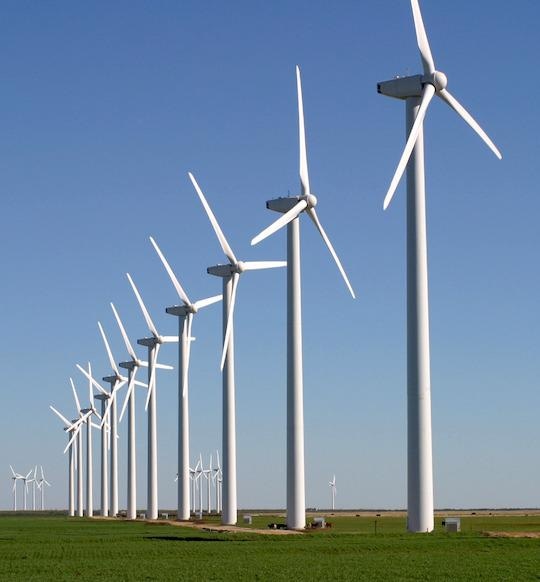Texas can serve as a model on how to efficiently substitute coal with solar and wind for the energy requirements of the state while adhering to environmental targets, according to a new study by engineers from Rice University.
 The Brazos Wind Farm, near Fluvanna, Texas. A Rice University study finds that building a fraction of the wind and solar projects already proposed in Texas could eliminate the state’s remaining coal power plants and their emissions. Image Credit: Wikipedia
The Brazos Wind Farm, near Fluvanna, Texas. A Rice University study finds that building a fraction of the wind and solar projects already proposed in Texas could eliminate the state’s remaining coal power plants and their emissions. Image Credit: Wikipedia
The new study directed by Daniel Cohan, an environmental engineer, and senior computer science major Richard Morse of George R. Brown School of Engineering at Rice University applies optimization modeling to detect the lowest-cost combinations of planned solar and wind projects with the possibility of substituting coal-driven power generation in Texas.
As the researchers state in the article, published in the journal Renewables: Wind, Water, and Solar, “Simply put, it’s not always windy and not always sunny, but it’s almost always windy or sunny somewhere in Texas.”
Cohan stated that could enable solar and wind to substitute almost all coal output, particularly if solar and wind projects are situated in locations that offer complementary output. The new article is based on a study carried out in 2018 from his lab.
This paper is really about how we can transition away from coal as quickly as possible. Texas still burns more coal and emits more sulfur dioxide and other pollution than any other state. Even though a transition is inevitable, it’s urgent that we move off coal as quickly as possible to improve air quality and health.
Daniel Cohan, Study Lead and Associate Professor of Civil and Environmental Engineering, Rice University
“Cleaning up the energy that we use to power society is one of the most important things we need to do,” said Morse, who won the Malcolm Verdict Memorial Poster Competition at the 2020 Texas Energy Summit for his work on the project. “Professor Cohan advertised it as a math-leaning project, and that’s my background, so being able to help with a clean-energy integration project was very interesting to me.”
More than a few large Texas coal plants shut down in 2018, and the majority of remaining plants have functioned far below capacity, including during outages in the 2021 February freeze. The team’s study found that only a third of the solar and wind projects already suggested to the Electric Reliability Council of Texas by June 2020 could substitute nearly all of the coal generation of the state.
As of June 2020, dozens of those projects have been constructed, and the queue of anticipated solar projects has doubled.
The path to success for solar and wind will be the development of transmission lines linking the sunniest and windiest parts of the state of Texas to cities.
In Texas, that’s the biggest bottleneck slowing the growth of wind and solar. The bipartisan infrastructure bill that passed last year is a good start, but doesn’t have nearly enough funding for transmission. Also, by not connecting to other grids, Texas has missed out on opportunities to sell surplus wind and solar power to other states.
Daniel Cohan, Study Lead and Associate Professor of Civil and Environmental Engineering, Rice University
Cohan noted that natural gas will continue to be important to the state’s electric reliability in the near future, particularly as ERCOT works to recuperate from the 2021 freeze. However, complementary location of solar and wind farms can decrease the need for natural gas and storage and exclude the need for coal, he stated.
The study reveals that wind energy from West Texas tends to surge overnight, whereas South Texas wind surges with sea breezes on summer evenings and afternoons. Along with daytime solar, these complementary projects can encompass the majority but not all hours of the year.
Even with complementary siting, there will still be hours when the sun isn’t shining and the wind isn’t blowing. Historically, the main challenge has been summer afternoons when air conditioners are running full blast, and the occasional deep freeze. Solar and coastal winds perform well during summer peaks, but can have lulls on some evenings when we’ll need something else to kick in.
Daniel Cohan, Study Lead and Associate Professor of Civil and Environmental Engineering, Rice University
Cohan stated it is only a matter of time before coal is excluded from Texas' grid.
I think none of the power companies want to run coal plants long-term. They’re dirtier and costlier to operate than building wind and solar projects from scratch, and most utilities companies now have plans to reach net-zero carbon emissions by 2050, if not before. Perhaps because of that, they haven’t been investing in upgrades to their coal plants, many of which are more than 40 years old and aren’t very efficient.
Daniel Cohan, Study Lead and Associate Professor of Civil and Environmental Engineering, Rice University
The study’s co-authors are Rice undergraduate civil engineering major Sarah Salvatore and alumna Joanna Slusarewicz, currently a graduate student at Carnegie Mellon University.
The research was supported by Energy Foundation.
Journal Reference:
Morse, R., et al. (2022) Can wind and solar replace coal in Texas?. Renewables: Wind, Water, and Solar. doi.org/10.1186/s40807-022-00069-2.